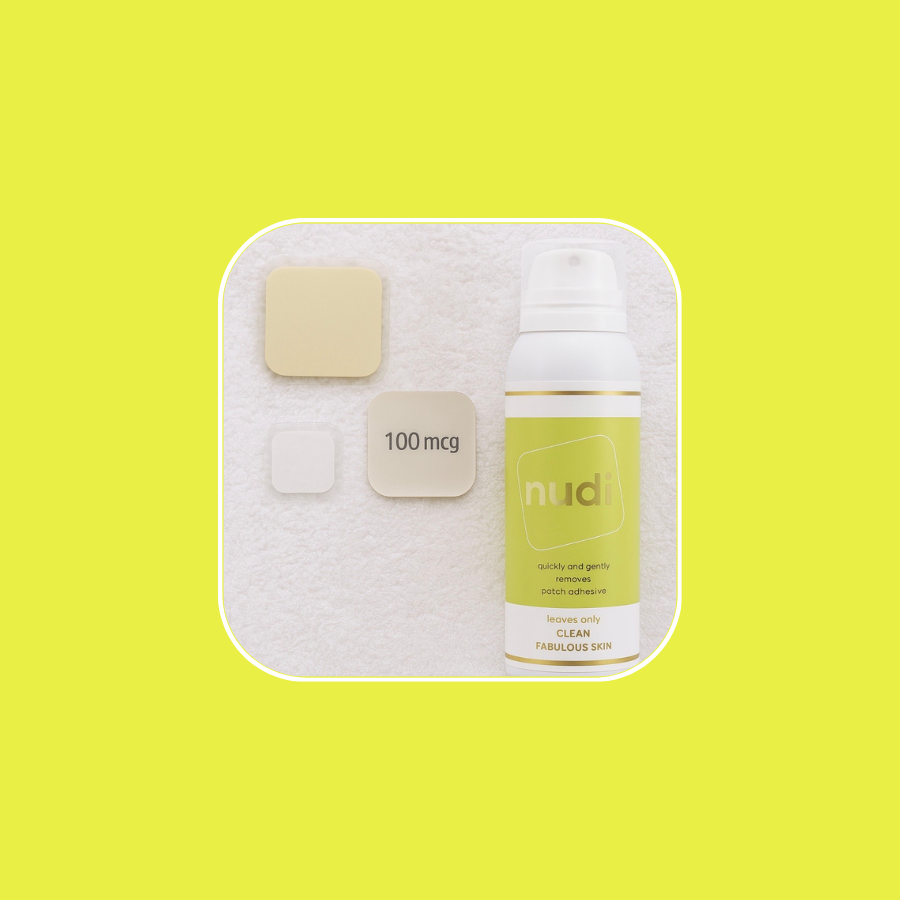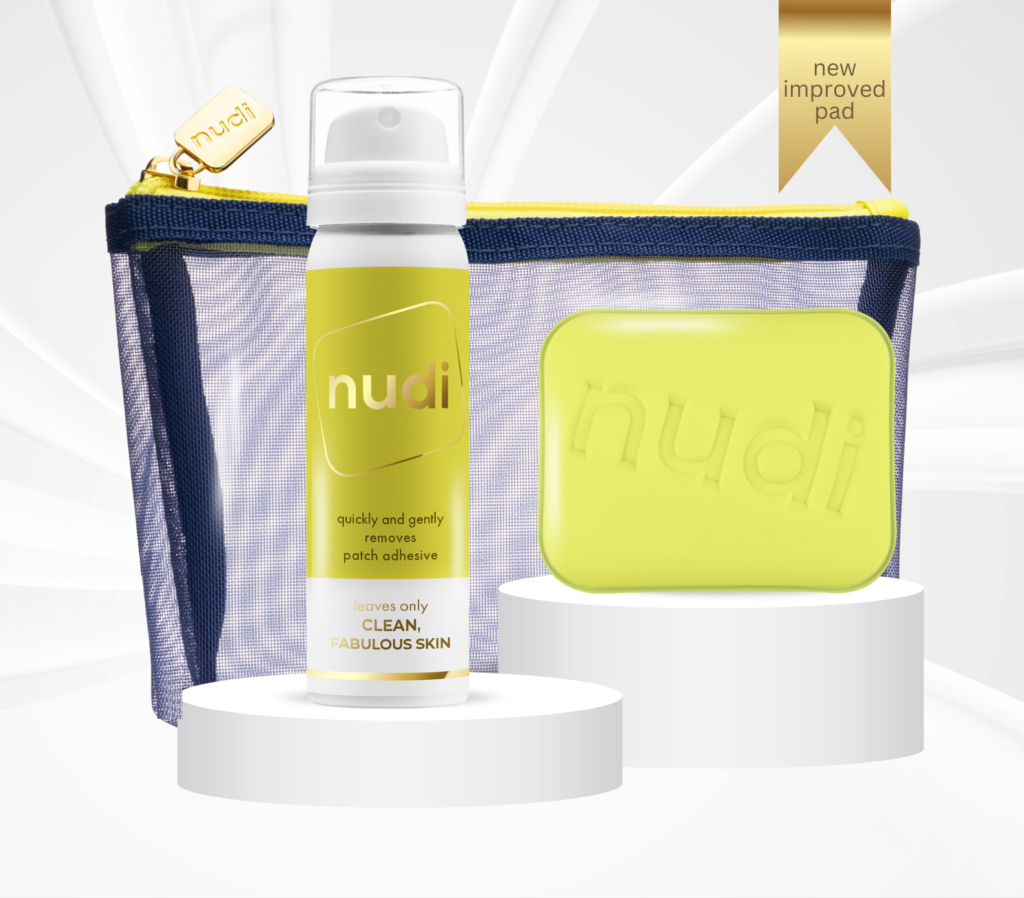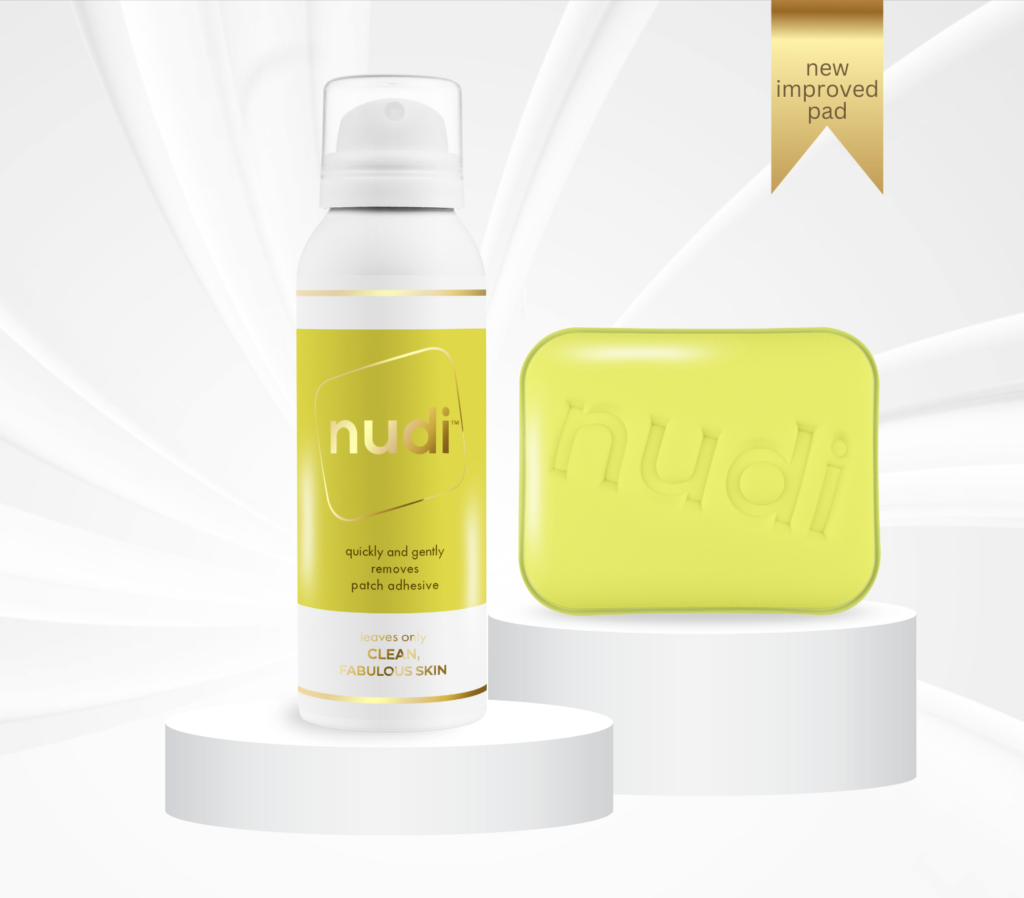
Understanding HRT Patch Dosages and What You Need to Know
Menopause is a natural stage of life, but that doesn’t mean the symptoms are easy to manage. From hot flushes to mood swings, every woman’s experience is unique, and that’s where Hormone Replacement Therapy (HRT) comes in. One of the most popular forms of HRT today is the oestrogen patch. These small, discreet patches deliver a steady dose of hormones through the skin, offering relief from many menopause symptoms without the daily hassle of pills.
But here’s the thing: not all HRT patches are created equal. Understanding HRT patch dosages, from standard to high strength, can help ensure you’re getting the right treatment for your needs. This blog will walk you through the different oestrogen patch strengths, how they work, and how to care for your skin along the way.
We’ll also introduce a little helper: Nudi Spray™, a vitamin E enriched solution that gently removes sticky adhesive residue from HRT patches, because the right dosage isn’t just about hormone levels; it’s also about your comfort.
Note: This blog is for educational purposes only and is not a substitute for medical advice. Always consult with a healthcare professional before making changes to your HRT treatment.
Understanding Oestrogen Patch Dosages
Standard Dosages
Most HRT patches come in dosages ranging from 25mcg to 100mcg of oestradiol, the primary form of oestrogen used in transdermal oestrogen therapy. These patches are applied directly to the skin, usually twice a week, and release a controlled dose of oestrogen over time.
Your doctor might start you off on a lower dose, like 25mcg or 50mcg, especially if you’re just beginning menopause hormone therapy. These lower strength patches are often enough to manage mild symptoms such as hot flushes, night sweats, or mood changes. For some women, though, this dosage may not be quite strong enough.
Choosing the right patch is a collaborative process. Your doctor will consider your hormone levels, symptom severity, and general health before selecting a starting dose. If needed, they can adjust your dosage over time to make sure you’re getting the symptom relief you deserve.
Higher Dosages
Some women experience more intense symptoms and may not get sufficient relief from standard dosages. That’s where higher strength patches, like 150mcg, 200mcg, or even 300mcg, come in. These are not usually prescribed as a first step but may be considered when lower doses fail to provide adequate relief.
Keep in mind that high dose HRT isn’t without risks. These patches require close supervision and ongoing discussions with your doctor. Your provider will likely want to monitor things like blood pressure, weight, and potentially blood tests to ensure the treatment is safe and effective for you.
There’s no one size fits all here. Individualised HRT treatment is key, and sometimes finding the right patch is a journey that involves a bit of trial and error.
Factors Influencing Dosage Requirements
Individual Absorption Rates
One of the more surprising things about HRT patch dosages is that how much oestrogen your body actually absorbs can vary from person to person. Just because the label says 100mcg doesn’t mean that’s what your body is absorbing.
Factors like skin thickness, hydration, and even where on your body you place the patch can affect hormone absorption through skin. For example, applying a patch to fatty areas like the lower abdomen may result in different absorption compared to the buttocks or thighs.
This is why rotating HRT patch application sites is important. It helps reduce irritation and provides more even hormone delivery. If you’re not feeling the effects you expect from your patch, it may not be a dosage issue but rather an absorption one. Talk to your provider. They might suggest trying a different location or adjusting the strength.
Symptom Severity and Health Considerations
The severity of your menopause symptoms is a major factor in determining the right dosage. If you’re experiencing severe hot flushes, vaginal dryness, insomnia, or mood swings, a higher dose may be justified.
But your doctor will also take into account your age, whether you’ve had a hysterectomy, your family history, and any chronic conditions like high blood pressure or diabetes. For example, postmenopausal women with an increased risk of blood clots or breast cancer might be advised to stay at lower doses or consider alternatives.
It’s all about finding the sweet spot: the lowest effective dose that provides relief without introducing unnecessary risks.
Safety and Monitoring of High Dose HRT
Medical Guidelines and Recommendations
The general principle with hormone replacement therapy (HRT) is to use the lowest effective dose for the shortest amount of time necessary. However, “lowest effective” means different things for different people. Some women simply don’t respond to lower doses and may require high dose HRT to function and feel like themselves again.
Medical guidelines acknowledge that individualised HRT treatment is essential. While there’s no universal “maximum” dose, patches delivering over 100mcg should always be prescribed with caution and frequent monitoring.
You and your provider should regularly review your symptoms, side effects, and overall health status. Adjustments may be made over time depending on how your body responds.
Potential Risks and Side Effects
Like any medication, HRT comes with potential risks, especially at higher doses. Side effects of oestrogen patch use may include:
- Breast tenderness
- Headaches
- Nausea
- Skin irritation
- Irregular bleeding or spotting
- Weight gain
More serious concerns at higher doses include:
- Endometrial hyperplasia (if oestrogen is used without progesterone in women with a uterus)
- Increased risk of breast cancer with long term use
- Slightly increased risk of blood clots or stroke
These risks vary from person to person, which is why long term HRT safety needs to be regularly assessed by a healthcare provider.
Practical Tips for HRT Patch Users
Proper Patch Application
Applying your patch correctly is just as important as choosing the right strength. For best results:
- Choose clean, dry, hairless areas on your lower abdomen or buttocks.
- Avoid applying patches to areas that are oily, broken, or irritated.
- Don’t place patches in the same spot every time. Rotate sites to help reduce skin irritation from hormone patches.
- Press the patch firmly in place for about 10 seconds to ensure it sticks well.
And yes, you can still bathe or shower with most patches on, but avoid soaking in hot baths for too long, as this may cause the patch to loosen or fall off.
Managing Adhesive Residue and Skin Care
Let’s talk about the less glamorous part of using HRT patches: that sticky adhesive gunk that stays on your skin after you remove a patch. Not only is it annoying, but if left untreated, it can cause skin irritation.
That’s where Nudi Spray™ comes in. This adhesive remover is specially designed to clean off leftover medical adhesive without causing redness or stinging. Plus, it’s enriched with Vitamin E, which nourishes your skin and promotes healing, an especially welcome benefit if you’re dealing with dryness or sensitivity from frequent patch use.
Unlike some harsh alcohol based removers, Nudi Spray™ is gentle enough for everyday use and keeps your skin feeling fresh, not stripped.
Choosing the right HRT patch dosage is about more than just numbers, it’s about reclaiming your quality of life during menopause. Whether you’re using a standard dose or exploring higher dose HRT, the key is to work closely with your healthcare provider and listen to your body.
There’s no universal “best HRT patch for menopause.” What works for your friend or sister may not work for you, and that’s okay. This is your journey.
And while you’re navigating it, don’t overlook the importance of good skincare. Tools like Nudi Spray™ can make your HRT experience more comfortable by gently removing leftover adhesive and nourishing your skin with Vitamin E skincare benefits.
So whether you’re just starting out or considering a dosage change, keep asking questions, stay informed, and prioritise your comfort and wellbeing.
Frequently Asked Questions
1. What is the highest available dose of HRT patches?
Most standard patches range up to 100mcg, but in special cases, doctors may prescribe higher doses such as 200mcg or 300mcg for severe symptoms. These are typically compounded or specialty patches.
2. Are higher dose HRT patches safe?
They can be, but they require close monitoring. Your doctor will evaluate the benefits and risks based on your health history and symptoms.
3. How do I know if I need a higher dose HRT patch?
If you’re still experiencing symptoms such as hot flushes, insomnia, or mood swings on a standard dose, consult your doctor. A blood test or symptom diary can help guide next steps.
4. Can I switch HRT patch doses on my own?
Definitely not. All dosage changes should be discussed with your healthcare provider to ensure safety and proper monitoring.
5. How can Nudi Spray™ assist HRT patch users?
Nudi Spray™ helps remove leftover adhesive after patch removal, preventing skin irritation from hormone patches. Its vitamin E rich formula also soothes and nourishes the skin.
Our Products

Adhesive Remover Starter Kit
Designed to remove the most stubborn patch or tape glue from all skin types in a neat travel sized pack .
- Nudi Spray™ 50ml
- Easi Pad™
- Nudi™ Patch Bag
£15

Glue Free Forever!
Subscribe & Save
Enjoy our great value subscription direct to your door without giving glue another thought.
- Nudi Spray™ 100ml
- Easi Pad™
- Cancel anytime
£16

Top Up!
Designed to remove the most stubborn patch or tape glue from all skin types in our larger 100ml can.
- Best Seller
- Nudi Spray™ 100ml
- Easi Pad™
